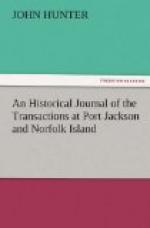When we entered the room a signal was made from the palace, and the fort began to fire. Orders had been left with the commanding officer on board the Sirius, to begin to salute after the fort had fired two guns, which was particularly attended to, and a salute of twenty-one guns was given. It is rather uncommon upon such occasions, for an English ship of war to salute at so early an hour, but certainly the greatest compliment which we could at such time pay them, was to observe in this case the custom practised by their own ships.
On Monday the 3d of September, the watering of the convoy, and every other part of their refitting being compleated, the signal was made from the Sirius for every person to repair immediately on board their respective ships, and at the same time the signal for unmooring was shown; and on Tuesday morning, with a light breeze from the land, we weighed with the convoy. When the Sirius had got within about half a mile of Fort Santa Cruz, that castle saluted us with 21 guns, which was answered by us with the same number; a very high and uncommon compliment, and such I believe as is seldom paid to any foreigner; but was no doubt meant as a suitable return to the attention paid by his Majesty’s ship to the birth-day of the Prince of Brazil. We carried wind enough out to run us clear without the islands before night.
The harbour of Rio de Janeiro may be known when you are off it, by a remarkable hill at its entrance, called Pao d’Asucar, from its resemblance to a loaf of sugar; but there is a hill to the south-east of the harbour, which is called by some the False Sugar-loaf; but which, as you view it from the eastward, I think has more the appearance of a church, with a short spire steeple; this hill points out the harbour to ships at a distance, much better than Pao d’Asucar. The land to the westward of the harbour is high and broken, and is commonly so covered with clouds, that you cannot discover the true make of it.
Right off the harbour lie several small islands, all steep to, or nearly so; a few rocks project a very small distance from some of them, but which cannot be considered dangerous, as no person possessed of common prudence would ever take a ship so near as they lye; within those islands (if you have not wind to carry your ship into the harbour) you may anchor; the best birth for getting under way with any wind, is to bring the island Raz (a low island) to bear south or south half west one mile, in 14 or 15 fathoms water, soft bottom; there is nothing in the way between this anchorage and the harbour; you will observe in the entrance a small island or rock, fortified, called Lage; you sail about mid-channel between this island and Fort Santa Cruz, observing that the tide of flood sets upon Santa Cruz point, and the ebb upon the island; the soundings from the outer anchorage decrease from 14 fathoms, where we lay, regularly, till near abreast of the Sugar-loaf, where it is six and a half fathoms: from this depth you drop into 12, 14, and 16 fathoms. Run up, and anchor off the town in 17 or 18 fathoms, clear soft ground.




